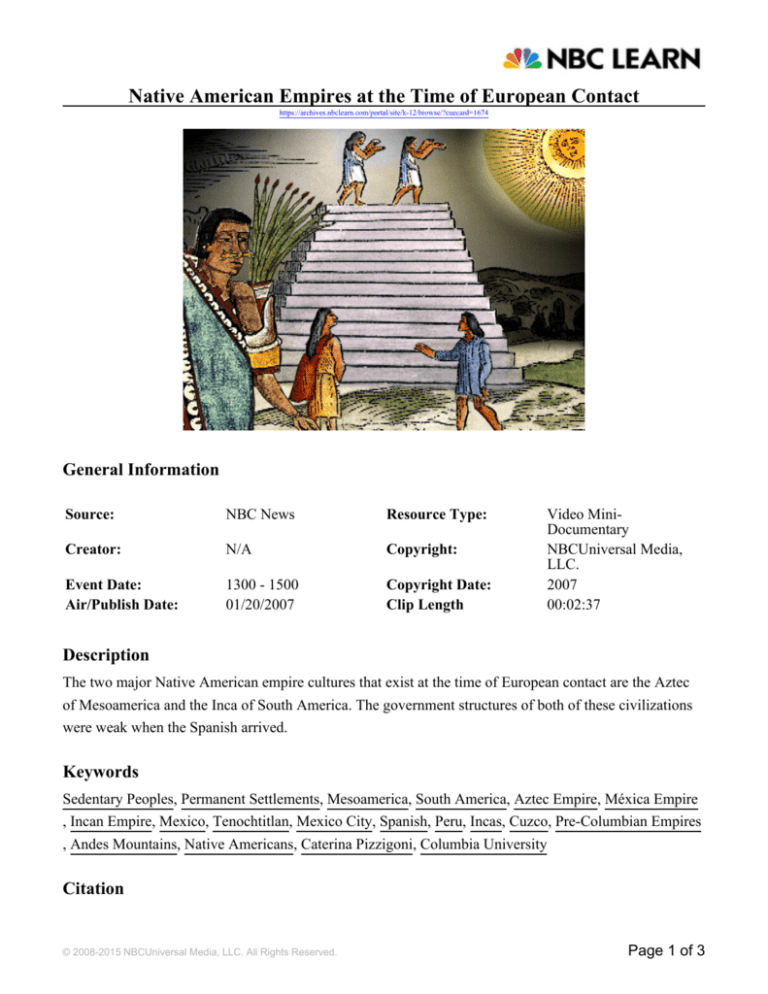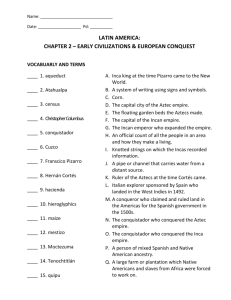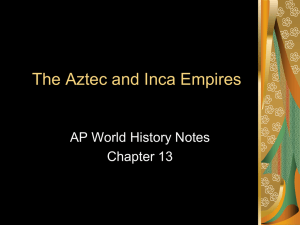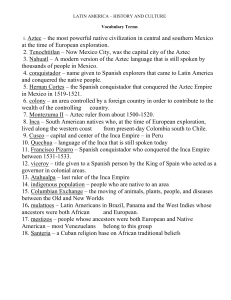
Native American Empires at the Time of European Contact
https://archives.nbclearn.com/portal/site/k-12/browse/?cuecard=1674
General Information
Source:
NBC News
Resource Type:
Creator:
N/A
Copyright:
Event Date:
Air/Publish Date:
1300 - 1500
01/20/2007
Copyright Date:
Clip Length
Video MiniDocumentary
NBCUniversal Media,
LLC.
2007
00:02:37
Description
The two major Native American empire cultures that exist at the time of European contact are the Aztec
of Mesoamerica and the Inca of South America. The government structures of both of these civilizations
were weak when the Spanish arrived.
Keywords
Sedentary Peoples, Permanent Settlements, Mesoamerica, South America, Aztec Empire, Méxica Empire
, Incan Empire, Mexico, Tenochtitlan, Mexico City, Spanish, Peru, Incas, Cuzco, Pre-Columbian Empires
, Andes Mountains, Native Americans, Caterina Pizzigoni, Columbia University
Citation
© 2008-2015 NBCUniversal Media, LLC. All Rights Reserved.
Page 1 of 3
MLA
"Native American Empires at the Time of European Contact." NBC News. NBCUniversal Media. 20 Jan.
2007. NBC Learn. Web. 18 March 2015
APA
2007, January 20. Native American Empires at the Time of European Contact. [Television series episode].
NBC News. Retrieved from https://archives.nbclearn.com/portal/site/k-12/browse/?cuecard=1674
CHICAGO MANUAL OF STYLE
"Native American Empires at the Time of European Contact" NBC News, New York, NY: NBC
Universal, 01/20/2007. Accessed Wed Mar 18 2015 from NBC Learn:
https://archives.nbclearn.com/portal/site/k-12/browse/?cuecard=1674
Transcript
Native American Empires at the Time of European Contact
NARRATOR: Before the Colonists arrived, the largest civilizations in America were the Incan Empires
and the Aztec, or the native Méxica.
CATERINA PIZZIGONI (Columbia University): The history of the Méxica empire, started with the
Méxica people coming down from Northern Mexico, and moving into the central valley, where they
founded what was going to become the capitol that nowadays is Mexico. And the empire started from the
foundation of the city in 1325.
NARRATOR: Nearly 250,000 people lived in the vast city of Tenochtitlan, located near present-day
Mexico City. They built massive pyramids and complex waterways and canals. The Aztec city rivaled
most of those of Europe. By comparison though, when the Spanish arrived, the Aztec civilization was
relatively new.
PIZZIGONI: And we can think of the Méxica empire as a very young empire for the time. Because if you
think about it, the expansion started in 1428. And the Spanish arrived in 1519. So, it's like 100 years. It's
nothing in terms of European history, when you think of the Roman empire.
NARRATOR: There was another big difference between the Aztecs and those older civilizations. The
Aztecs were really a group of many different cultures. Although they all served under one emperor, the
loyalties were to their ethnic leaders. This would become a great weakness of the Aztecs.
PIZZIGONI: It was not unified. And therefore, it was not a solid empire. So, when the Spanish came in,
they found allies that were willing to fight on their side
NARRATOR: The Inca empire was similarly impressive but similarly weak. In what is now Peru, the
Incas mastered the technique of building communities in the Andes Mountains. The city of Cuzco was the
center of the Inca civilization.
PIZZIGONI: The Incan empire was built on verticality, in the sense that the geography, the landscape was
completely different.
© 2008-2015 NBCUniversal Media, LLC. All Rights Reserved.
Page 2 of 3
NARRATOR: However, like the Aztecs, the Inca’s vast civilization was loosely held together and
therefore weak.
PIZZIGONI: The similarities between the Méxica empire and the Inca empire are many.
NARRATOR:
Both the Méxica and Inca, although vast and powerful empires, were still young and their government
structures not completely united. By the time the Europeans arrived, both Native American empires were
primed for conquest.
© 2008-2015 NBCUniversal Media, LLC. All Rights Reserved.
Page 3 of 3










